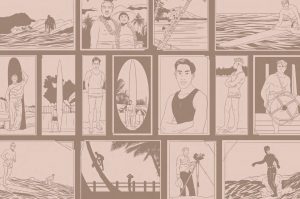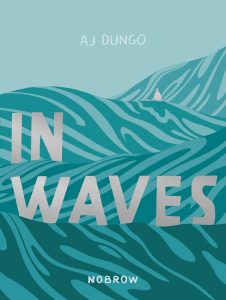AJ Dungo, a surfer and illustrator who resides in Southern California, will release IN WAVES, his debit graphic novel, on June 4, 2019. In this visually stunning and emotionally gripping memoir, Dungo details his love of surfing while also interweaving the tale of his late partner Kristen’s battle with cancer against the rise and friendship of surfing greats Duke Kahanamoku and Tom Blake.
Dungo never considered a career as an artist until he entered community college. He worked as a designer for a footwear company before embarking on a career as a graphic novelist. Dungo was kind enough to chat with The Beat about IN WAVES and how the spiritual power of surfing provided solace in grief.
Nancy Powell: What feelings are running through you on the eve of IN WAVES’ publication?
AJ Dungo: It’s strange. I’ve worked on this book nonstop for a few years and now that I’ve finished everything, the abrupt halt to the daily grind of cranking pages out is kind of jarring. But slowly, I’ve been acclimating to normal life again. I’m feeling extremely grateful at the moment.
Powell: I was pretty blown away with the book. Throughout the highs and lows of love and illness, there was always this weird sense of calm. How were you able to maintain that this serenity in the face of such despair?
Dungo: Thank you for your kind words. That’s very generous of you to say.
That’s interesting. I’m not entirely sure. Kristen made it so easy to forget that she was sick at all. Most people didn’t even know she was missing a leg. She didn’t make her situation the focal point so I think that put us all at ease even though in reality she was in this perpetual struggle.

Powell: I loved your use of sepia and aqua to depict the two parallel histories—sepia for the historical and aqua for the present. It made for some pretty effective storytelling. Why did you make this choice?
Dungo: It was a way to ground the reader in the timeline they’re reading. Sam at Nobrow recommended it and also wanted me to utilize color throughout the book. I wanted to do everything in some sort of limited palette but due to time constraints and the massive page count, we settled on the two colors. Sepia was a pretty obvious choice for the past narrative and I picked blue for the present because of that color’s connotation to mood.
Powell: The details that you use to capture Bolsa Chica State Beach and all those Orange County locales in your drawings are instantly recognizable, a local’s point of view. Did you grow up in and around Orange County?
Dungo: Those were some of my favorite spreads to draw. I was born in Fort Myers, Florida but I spent most of my youth in Southern California. I’ve bounced around South East Los Angeles and Orange County.
Powell: How much research did you have to conduct on Duke Kahanamoku and Tom Blake in order to tie their history into the overall narrative?
Dungo: A ton of research. For the majority of my time working on the book, I was reading and writing about the surf history aspect of the comic. As soon as I got the green light from Nobrow, I was in bookstores just poring over every book I could find on the subject. Luckily there are so many great books that have compiled and organized every era of surfing from its inception to present day. Books by Matt Warshaw, Jim Heimann, and Croul Publications were key to the historical portions of the book. It made my herculean task of summarizing it all that much simpler.
Midway through writing the book, I met Randy Hild, a legend in the surf industry. He was a close friend of an instructor of mine. He invited to me to his home where he laid out Hawaiian surfboards, original prints, and artifacts that I had been seeing in the books I had found in the bookstores months before. He later mailed me a box full of surf history books and surf ephemera; he put me on to so much stuff.
He then introduced me to the owner of the estate of Tom Blake, Spencer Croul, who was also the father of a classmate that I went to art school with. It was there in Spencer’s studio where I had the rare opportunity to look at Tom Blake’s notebooks, original photos, and prized possessions. Both of these men helped enrich the book by pulling back the curtain on their personal collections of these mythical figures.
Powell: How long did it take for you to write and draw IN WAVES?
Dungo: Almost three years. I started working on it the summer of 2016. Writing and sketches took about a year and a half, drawing the finished artwork took a year and some change. During the writing process, I was sending drafts to Nobrow to be approved but there was always something to improve or expand upon. What started as an 80-page offering became an almost 400-page tome. After about four drafts over a year and a half long period, I had the approval to start the finished artwork.
It was a difficult process because I was working full time as a CMF designer for a footwear company but in my off hours and weekends I was working on the book full time. Every waking moment that I wasn’t designing shoes, I was working on In Waves. I used my office as a studio, so I spent everyday at work. I would also drive to the office during weekends to work because I was using their equipment to put the book together. I was so stressed out. The only rest I’d get was when I’d go to bed at night. I felt like Bill Murray in Groundhog Day.
Powell: How difficult was it for you to put your memories down on paper?
Dungo: I had lost Kristen four months before Nobrow reached out to me. At first I thought it was too soon, it was all too raw for me to write about. I felt like I hadn’t even processed what I was experiencing yet. I actually didn’t start to work on it for a couple months because I was so overwhelmed. Nobrow was checking in periodically and I had nothing to show them. At one point, I was so defeated that I had an email written out to Nobrow thanking them for the opportunity. But before I sent it, I thought about how Kristen would have felt at the thought of me giving up before I had even started. It was such a golden opportunity and I was going to squander it out of fear and anxiety. And at that moment, I decided to fully commit to finishing this book.
The whole process was extremely cathartic. The countless hours of self-induced isolation and reflection helped me face the emptiness of Kristen’s absence that had engulfed me. In retrospect, I’m very grateful to have had the opportunity to put everything down while it was fresh because I feel that had I waited, I would have forgotten so many important details.
Powell: Have Kristen’s family, Jeff and her mother in particular, read IN WAVES? What were their reactions?
Dungo: I gave advanced copies to Jeff, Kristen’s mom, and Eon. Eon and his fiancé were so excited to receive it, they read it together and sent me photos of their favorite spreads in real time. Jeff read it as well and his response was so moving to me. Kristen’s mom just finished it. She took it to work one night and she said she cried a lot. She told me she loved it. The responses I’ve received from the preview copy recipients have been overwhelming and touching. Everyone has been so supportive and people seem to really connect to the story in a profound way. I’m constantly floored by their feedback.
Powell: Who has influenced you the most artistically?
Dungo: I don’t think I can name one person. As a young child, my grandmother was very encouraging and always had me and my siblings making art. As a young artist I was really into Raymond Pettibon, his flyers and album covers still have an effect on me. As an art student my first true inspiration was probably James Jean. His books really opened up my mind to the possibility of a future in art making. But there are so many people that influence me artistically; musicians, filmmakers, photographers, writers it’s too difficult to name one solitary figure.
Powell: Which comic books have you read that has provided the most inspiration in your storytelling?
Dungo: Killing and Dying was huge for me. The simplicity and space, the fluidity and writing, it’s all so succinct and tasteful. I constantly referred back to that. Jillian Tamaki’s comics were big as well, her compositions and page layouts were guiding lights for me. Fun Home, It Never Happened Again, Powr Mastrs, Blankets, Lose, Crickets, Asterios Polyp, Patience, Arsene Schrauwen, anything by Connor Willumsen, Katsuhiro Otomo, Simon Hanselmann, Daniel Clowes, Charles Burns, Chris Ware, so many books were in rotation during the writing process.
Powell: If you had to pick a comic book writer or artist that you would next like to work with, who would that be?
Dungo: My good friend Brandon Dumais, he’s an amazing writer. We’ve made comics together before and they were always a pleasure to do. He actually edited and proofread my first drafts of In Waves and made huge improvements to the narrative.
Powell: Now that you’ve created this powerful memoir with IN WAVES, are there any fictional stories you’d like to tell?
Dungo: I’m not sure about specifics just yet. I just know that I’d like to do more short form comics. I’ve always felt that I wasn’t imaginative enough to make a good fictional story but I’d be down to take that challenge on now. Whatever I do next, I would love to do at my own pace.
Powell: Finally, what do you think Kristen would say knowing that her life has been immortalized on the pages of IN WAVES?
Dungo: I think she would hug me for a really, really, really long time. And then she would say, “I told you so.”










Autocorrect typo: Debit for ‘debut’ in the first paragraph.
Comments are closed.